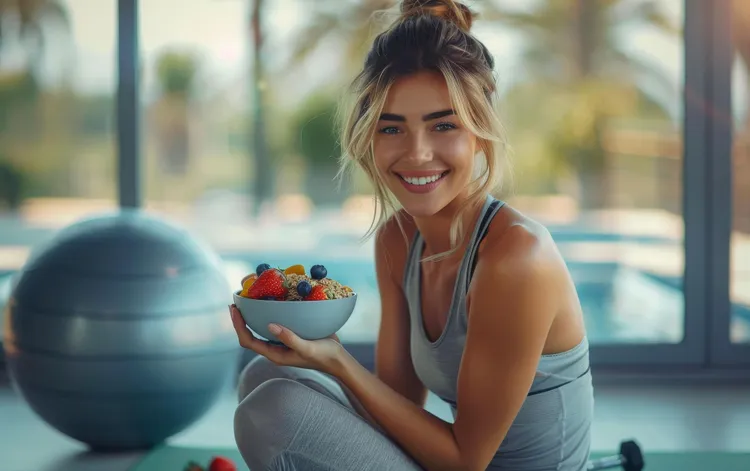Healthy Snacks: Nutritious and Satisfying Options for Any Time
In a world where convenience often trumps nutrition, finding healthy snacks that are both satisfying and nutrient-packed can be a game-changer. Snacking done right fuels your body, stabilizes energy levels, boosts mental focus, and supports overall well-being. Whether you’re navigating a busy workday, fueling a workout, or keeping kids happy, healthy snacks can bridge the gap between meals without derailing your diet.

Why Healthy Snacking Matters
Snacking has a bad rap, often associated with mindless munching on chips or candy. But when done thoughtfully, snacking can be a powerful tool for health. Here’s why it matters:
- Sustained Energy Levels: Snacks with a balance of protein, healthy fats, and complex carbs prevent blood sugar spikes and crashes, keeping you energized.
- Improved Focus and Mood: Nutrient-dense snacks provide the brain with steady glucose and mood-boosting nutrients like omega-3s or magnesium.
- Appetite Control: Smart snacking reduces overeating at meals by curbing hunger, supporting weight management goals.
- Nutrient Boost: Snacks are an opportunity to add vitamins, minerals, and fiber, especially if meals lack variety.
- Support for Active Lifestyles: Snacks fuel workouts, aid recovery, and keep kids active without relying on sugary treats.
Research, like a 2019 study in Nutrients, shows that well-timed, nutrient-rich snacks improve metabolic health and cognitive performance. The key is choosing snacks that nourish rather than just fill you up.
The Science of a Healthy Snack
A great snack combines nutrients to maximize satisfaction and health benefits. Here’s what to aim for:
- Protein: Promotes fullness and supports muscle repair (e.g., Greek yogurt, eggs, beans).
- Healthy Fats: Provides sustained energy and supports brain health (e.g., nuts, avocado, olive oil).
- Complex Carbohydrates: Delivers steady energy and fiber for digestion (e.g., whole grains, fruits, vegetables).
- Fiber: Enhances satiety and gut health (e.g., vegetables, legumes, seeds).
- Micronutrients: Vitamins and minerals like vitamin C, magnesium, or potassium boost overall health (e.g., berries, leafy greens).
Ideal Snack Formula: Aim for 150–250 calories with a mix of 10–15g protein, 5–10g healthy fats, and 15–30g complex carbs, depending on your activity level and goals.
Avoid: Snacks high in added sugars, refined carbs, or trans fats, which cause energy crashes and inflammation (e.g., candy, soda, processed pastries).
Top Healthy Snack Options
Here’s a curated list of nutritious, satisfying snacks for any time, backed by science and loved for their taste and versatility:
- Greek Yogurt with Berries and Chia Seeds
- Why: High in protein (10–20g per cup), antioxidants from berries, and omega-3s from chia seeds. A 2020 study in Frontiers in Nutrition linked yogurt to better gut and brain health.
- When: Mid-morning or post-workout for protein and energy.
- Apple Slices with Almond Butter
- Why: Apples provide fiber and vitamin C; almond butter adds healthy fats and protein. Fiber slows digestion, keeping you full longer.
- When: Afternoon slump or pre-workout for quick energy.
- Hummus and Veggie Sticks
- Why: Chickpea-based hummus offers protein and fiber; veggies like carrots or bell peppers add crunch and vitamins. A 2018 study in Nutrients linked legumes to better metabolic health.
- When: Midday or evening for a savory, low-carb option.
- Hard-Boiled Eggs with Cherry Tomatoes
- Why: Eggs are a complete protein with choline for brain health; tomatoes provide lycopene, an antioxidant.
- When: Morning or post-workout for muscle repair.
- Trail Mix with Nuts, Seeds, and Dark Chocolate
- Why: Nuts and seeds provide healthy fats and magnesium; dark chocolate (70%+ cocoa) offers flavonoids for cognitive health.
- When: On-the-go or late afternoon for a mood boost.
- Edamame with Sea Salt
- Why: Soybeans are rich in protein, fiber, and iron, promoting satiety and energy. A 2017 study in Appetite found edamame reduces hunger.
- When: Evening or pre-dinner to curb appetite.
- Whole-Grain Toast with Avocado and Hemp Seeds
- Why: Avocado provides monounsaturated fats; whole-grain toast offers fiber; hemp seeds add protein and omega-3s.
- When: Morning or pre-workout for sustained energy.
- Cottage Cheese with Pineapple
- Why: Low-fat cottage cheese is high in protein; pineapple adds vitamin C and natural sweetness.
- When: Post-workout or evening for a light, filling snack.
- Roasted Chickpeas
- Why: High in fiber and protein, chickpeas satisfy crunchy cravings without the trans fats of chips.
- When: Afternoon or movie night for a savory treat.
- Banana with Peanut Butter and Flaxseeds
- Why: Bananas provide potassium and carbs; peanut butter adds protein; flaxseeds offer omega-3s.
- When: Pre- or post-workout for quick energy and recovery.
- Tuna on Cucumber Slices
- Why: Tuna is rich in omega-3s and protein; cucumbers are hydrating and low-calorie.
- When: Midday or evening for a low-carb, high-protein option.
- Oatmeal Energy Bites
- Why: Oats provide fiber; nut butter and seeds add protein and fats; a touch of honey satisfies sweet cravings.
- When: On-the-go or afternoon for a sweet, portable snack.
Practical Strategies for Healthy Snacking
Making healthy snacks a habit requires planning and creativity. Here’s how to integrate them seamlessly:
- Prep in Advance
- Batch Prep: Boil eggs, roast chickpeas, or portion trail mix on weekends for grab-and-go snacks.
- Snack Station: Keep a fridge drawer or pantry shelf stocked with pre-cut veggies, yogurt, and nuts.
- Portable Options: Use small containers or baggies for on-the-go snacks like edamame or energy bites.
- Balance Macronutrients
- Pair protein, fats, and carbs for satisfaction (e.g., apple + almond butter, yogurt + berries).
- Avoid carb-only snacks (e.g., crackers alone) that spike blood sugar and leave you hungry.
- Time Your Snacks
- Snack every 3–4 hours if meals are far apart to maintain energy.
- Pre-workout: Choose carb-focused snacks (e.g., banana with peanut butter) 30–60 minutes before exercise.
- Post-workout: Opt for protein-rich snacks (e.g., Greek yogurt) within 30 minutes for recovery.
- Mindful Snacking
- Eat without distractions (no screens) to avoid overeating and savor flavors.
- Check hunger cues: Snack only when physically hungry, not out of boredom or stress.
- Portion control: Pre-measure snacks to avoid mindless munching (e.g., ¼ cup nuts, not the whole bag).
- Make It Fun for Kids
- Ants on a log (celery with peanut butter and raisins).
- Yogurt parfaits with colorful fruit layers.
- Veggie “faces” with hummus and bell pepper strips.
- Kid-Friendly Ideas:
- Involve Them: Let kids pick veggies at the store or help assemble snacks to boost interest.
- Tip: Use fun shapes or colorful containers to make snacks appealing.
- Satisfy Cravings Healthily
- Sweet Cravings: Try fruit-based snacks (e.g., yogurt with berries, banana with dark chocolate drizzle).
- Savory Cravings: Opt for roasted chickpeas, tuna on cucumbers, or hummus with veggies.
- Crunchy Cravings: Choose raw veggies, roasted nuts, or air-popped popcorn over chips.
- Hydrate Alongside Snacks
- Pair snacks with water or herbal tea to stay hydrated, as thirst can mimic hunger.
- Avoid sugary drinks like soda or juice, which add empty calories.
Overcoming Common Snacking Challenges
Healthy snacking can be tricky, but here are solutions to common barriers:
- Time Constraints
- Solution: Keep no-prep snacks like Greek yogurt cups, pre-cut veggies, or canned tuna on hand. Use 5-minute recipes like avocado toast.
- Tools: A small food processor for quick hummus or a microwave for steaming edamame saves time.
- Budget Limitations
- Solution: Buy in bulk (nuts, oats, chickpeas), choose frozen fruit, or grow herbs for flavor. Eggs and canned beans are affordable protein sources.
- Tip: Shop sales or visit discount stores for healthy staples.
- Picky Eaters (Kids or Adults)
- Solution: Blend veggies into dips or smoothies, pair new foods with favorites (e.g., hummus with crackers), or sweeten naturally with fruit.
- Tip: Introduce new snacks gradually without pressure.
- Unhealthy Cravings
- Solution: Keep tempting junk food out of the house. Stock satisfying alternatives like roasted chickpeas or dark chocolate.
- Tip: Address emotional eating with non-food solutions like a walk or journaling.
- Lack of Variety
- Solution: Try one new snack recipe weekly (e.g., energy bites or roasted veggies). Explore global flavors like tahini-based dips or miso-seasoned edamame.
- Tip: Rotate snacks to avoid boredom (e.g., savory one day, sweet the next).
The Role of Lifestyle in Smart Snacking
Snacking works best alongside other healthy habits:
- Exercise: Pair snacks with activity (e.g., banana pre-workout, eggs post-workout) to optimize performance.
- Sleep: Poor sleep increases junk food cravings. Aim for 7–9 hours nightly.
- Stress Management: Avoid stress-driven snacking with mindfulness or deep breathing.
- Meal Balance: Ensure main meals are nutrient-dense to reduce excessive snacking.
Long-Term Benefits of Healthy Snacking
A habit of nutritious snacking offers:
- Stable Energy: Fewer mood swings or fatigue from balanced blood sugar.
- Weight Management: Reduced overeating and better portion control.
- Nutrient Density: Increased intake of vitamins, minerals, and fiber.
- Cognitive Boost: Sharper focus and memory from brain-friendly nutrients.
- Overall Health: Lower risk of chronic diseases like diabetes or heart disease.
Getting Started: A Healthy Snack Ritual
Try this 5-minute ritual to kickstart your snacking habit:
- Choose a Snack: Hummus with carrot sticks.
- Set the Scene: Sit at a table with a glass of water.
- Savor It: Notice the crunch and creamy texture. Chew slowly.
- Reflect: Journal how you feel after snacking (e.g., energized, satisfied).
- Plan Ahead: Prep one snack for tomorrow to stay consistent.
Healthy snacking is a delicious, practical way to nourish your body and mind any time of day. By choosing nutrient-dense options like Greek yogurt, nuts, or veggies with hummus, and incorporating them with intention and variety, you can boost energy, curb cravings, and support long-term health. Start small, prep smart, and savor the journey to smarter snacking - one satisfying bite at a time.









